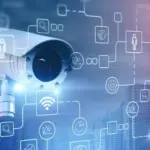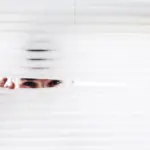Surely, at some point in our lives, we have had the feeling that someone is watching us or even that they are following us down the street. When this sensation becomes a firm and permanent belief, it is what is called delusion of persecution
In delusion of persecution or persecutory delusion, the person lives with a series of irrational ideas and beliefs in which he believes that he is being persecuted, spied on, or that different people or organizations are out to get him; almost always with the intention of attacking or causing harm, both physical and psychological.
This condition is experienced with great anxiety and can involve all the thoughts or aspects of the patient’s daily life, conditioning their relationship with any other person.
What is persecutory delusion? Definition and characteristics
According to the latest edition of the DSM-V diagnostic manual, a delusion would consist of “a false belief based on an incorrect inference regarding external reality, which is firmly held, despite the fact that almost everyone believes it and despite how much it constitutes a delusion.” incontrovertible and obvious proof or evidence to the contrary.”
In other words, A delusion is a completely irrational belief, without any demonstrable basis Belief that the patient maintains despite being shown that they are false. After clarifying this, we can explain the delusion of persecution as the false belief of being followed, harassed or harassed by one or more people.
This can mean a very serious condition for the patient, since his general thinking is inserted into irrational thinking; causing all the patient’s mental processes to revolve around his delusion.
Symptoms and signs
The main characteristic of delusions of persecution is the presence of alterations in the content of thought, especially due to distorted or false interpretations of the context or situation around you
A person who manifests delusions of persecution may think that his neighbors, or anyone he meets, are watching him.
The inferences made by someone with this disorder can be strident and random, so no specific stimulus is needed for the person to directly associate it with their delusion. Still, despite the characteristics of this deformation of thought, There are common thoughts typical of delirium of persecution
1. Being followed by someone
It is the most common of all ideations and consists of the belief that one or more people continually follow you. Furthermore, it is common for the person to associate this stalking with an intention to cause harm.
For example, the person who is chasing you does so with the intention of killing you.
2. Being spied on
Frequently, patients with delusions of persecution think that in addition to being followed by someone, that someone is doing so with the intention of spying on them for some reason. Hence, many of the people who suffer from them continually try to hide, causing a situation of very extreme insecurity and anxiety.
3. Being tormented
Another very common characteristic of delusions of persecution is the emergence of ideas of ongoing torment or harm. These people may believe that those who persecute them are making their lives miserable through small acts or situations.
In this case the subject may think that every time he does not find something it is because someone is hiding it from him.
4. Being ridiculed
Finally, one of the thoughts that are included in delusions of persecution is that whoever follows him does so with the intention of ridiculing or mocking him.
Common causes
Despite everything mentioned above, the manifestation of delusions does not constitute a pathology in itself, but rather arises as a symptom of one of the psychological alterations set out below.
According to the DSM-IV-TR, persecutory delusions are the most common form of paranoid schizophrenic delusions; but they can also appear in schizoaffective disorder, since it is the most common characteristic of the persecutory subtype of delusional disorder.
These delusions can also appear in manic and mixed episodes of bipolar disorder and in severe depressive episodes with psychotic properties.
Other pathologies in which we can find them are:
Types of persecutory delusions
There is not only one type of delusion of persecution, but These are divided into two types depending on whether the damage that the person thinks is going to be inflicted is physical or psychological
When the damage occurs physically, the subject feels harassed by people who want to cause some physical harm. Harm such as beating him, running him over, or even killing him.
However, if it occurs psychically, the patient believes that the attacks occur on a moral level. Trying to discredit him, make fun of him or have fun at his expense.
Diagnosis
Since these beliefs and ideations are usually extremely extravagant and not very credible, it is relatively easy to identify them and diagnose them as delusions.
Even so, for a correct diagnosis it is necessary to take into account a series of prior factors.
1. Differentiate between delusional ideas and overrated ideas
It is absolutely essential to make a differential diagnosis between a delusional idea and a habitual belief of the patient that is overrated. For example, This can get complicated when it comes to beliefs and ideas based on religion
Furthermore, when delusions of persecution are diagnosed, we must make sure that both the irrationality and the degree of conviction are absolute; since this is an unmistakable sign of delirium.
2. Detect changes or fluctuations in mood
If delusional beliefs appear only during manic, major depressive or mixed episodes, we are surely dealing with a mood disorder with psychotic symptoms.
However, If it manifests itself without any type of mood disturbance, it should be diagnosed as schizoaffective or schizophreniform disorder
3. Investigate the causes of delirium
Since persecutory delusion is a symptom within a broader pathology, it is necessary to evaluate the patient’s condition and symptoms With the intention of diagnosing any of the related pathologies mentioned above.
4. Rule out medical pathology or substance abuse as a cause.
As mentioned in the section on the etiology of delusions of persecution, sometimes these can be a consequence of the consumption of drugs or psychoactive substances, or they can even be the product of certain organic diseases.
Therefore, a medical examination or an evaluation of the substances consumed by the patient is essential to place these delusions in the correct diagnosis.
Treatment
It is essential to treat delusions of persecution as soon as possible , in order to stabilize the patient and ensure that the delusional ideas subside; even reaching hospitalization if necessary.
Thus, pharmacotherapy is an essential initial phase for the person’s improvement, with antipsychotic medications, such as risperidone or haloperidol, being the primary drugs for these symptoms.
Furthermore, when persecutory delirium is accompanied by high levels of anxiety or agitation, the administration of anxiolytic drugs such as benzodiazepines is common.
However, when delusional beliefs are caused by substance use or a medical illness, it is necessary to also treat these conditions, since they constitute the initial cause of the disorder.
Once the patient has been stabilized, psychological treatment is added, both at the individual and family level**. The most effective therapies to combat delusional ideas have turned out to be cognitive-behavioral**; as well as social skills training and rehabilitation measures.









